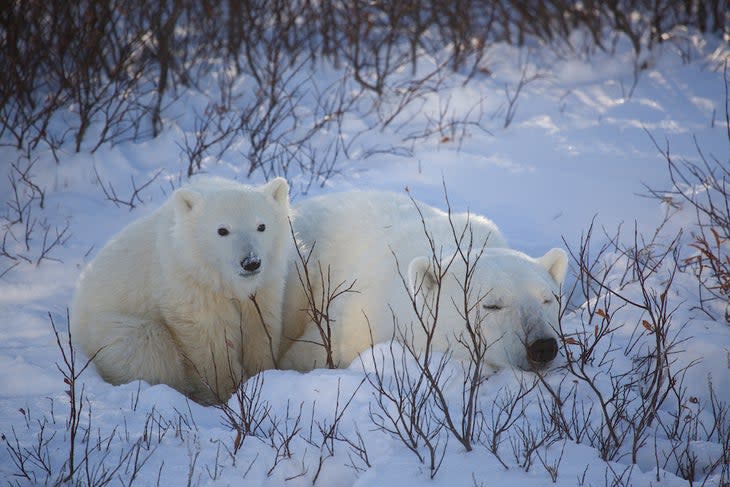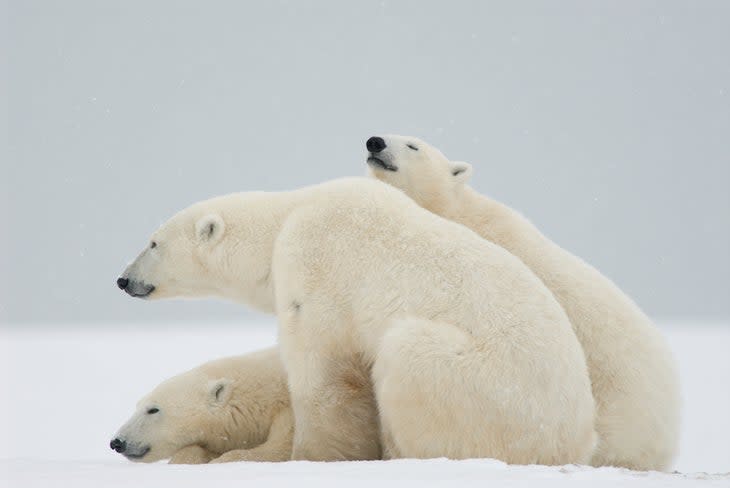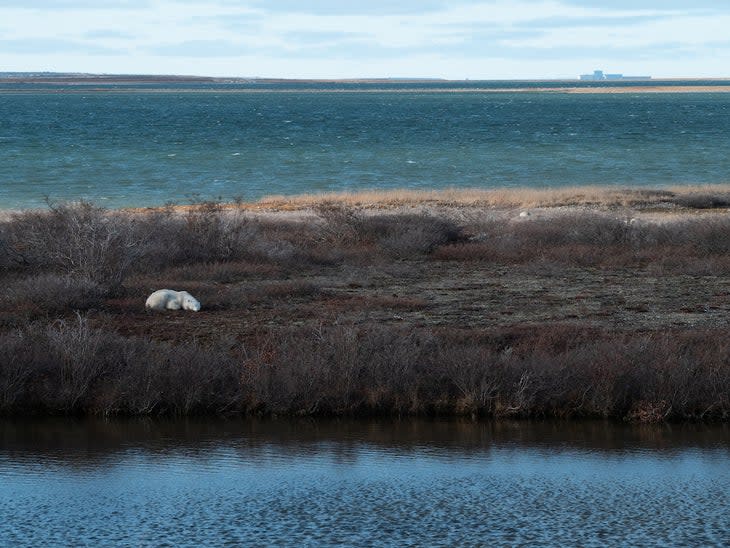My Coworkers Are Polar Bears. Here’s What It’s Like.
This article originally appeared on Backpacker
Not everyone gets to be within arms length of a polar bear during their 9 to 5. But, as the director of conservation outreach for Polar Bears International, Alysa McCall does. She’s using her platform to educate and raise awareness about the challenges polar bears face in the modern day, such as losing their arctic sea ice habitat to climate change.
McCall has been working in polar bear country for over a decade, doing research, tracking migration patterns, and now, helping people feel connected to animals sometimes thousands of miles away. For many, she is their bridge to polar bears, both on the screen and in person. Through PBI’s Tundra Connection webcast series, McCall teaches people at home about polar bears, often straight from the Tundra Buggy--an arctic-friendly monster truck that drives around designated trails to see animals in their element, from a safe distance. On the Buggy, McCall and PBI also drive around and livestream notable wildlife behavior for people at home to see. People can also join McCall on the Tundra Buggy in person and get a glimpse of these bears themselves.
Right now, McCall and PBI are focusing on their Detect and Protect research project that’s developing a radar system to give early warnings to communities about polar bears approaching. This is a more pressing problem as the climate gets warmer every year and these bears are coming to closer contact with people more and more often.
We got to chat with McCall live from Tundra Buggy One parked on the coast of Hudson Bay in Manitoba, Canada.
BP: As we’re transitioning into winter, what are the polar bears up to right now?
Alysa McCall: Hudson Bay has been ice-free all summer because it’s been warm, but we know that it will freeze up soon. Of course, sea ice is the polar bears’ main habitat. The polar bears, they’re getting excited because it’s going to freeze up. They’re starting to move toward the coast in anticipation of that ice freezing. Then they’ll get out there and start hunting seals, which is their main food. But, until it starts freezing, they’re hanging out. They’re conserving energy, they’re moving slow, they’re sleeping a lot. We know where they’re going to be.

BP: What does the Tundra Buggy let you see that other bear cams don’t?
AM: We have bear cams spread out through the tundra, but they’re all stationary. Us being the mobile camera, we can roll around to where the action is. It gives us more flexibility. If we hear that there are bears sparring down the way, we could go see that. Then if a mom and cub walks by, then we can turn around and slowly move the other way toward them. We’re always careful. We’ve never chased bears or crowded them. A lot of what we see is polar bears having a nap or sleeping or hanging out.
BP: How many polar bears can you see in a day?
AM: So much of it depends on what the weather’s doing that day. The bears seem to like it when it’s cool; no surprise there. We might see a little bit more action, a few more bears, on those days. As the weeks move on here into November, we start to see more bears coming in. At this time of the year, we might see two, three, four, or five bears. By the end of the season, before the ice freezes up, we could easily see over a dozen polar bears in one day, depending on what’s going on. Every day is a little different on the tundra. We’ve also got arctic and red foxes out here. There are birds, and we saw a wolverine once, which was super cool.
BP: In the past, you've studied the habitat selection patterns of polar bears in the western Hudson Bay. What have you learned from this?
AM: I used GPS collars to track female polar bears around Hudson Bay. The bears want to be out on the sea ice, one of the harshest, most remote, cold environments on the planet, so it’s hard to study them. With the GPS collars, though, we truly can get an idea of their movement patterns and how they use their habitat.
In my research, I was seeing different patterns in particular times of the year that females without cubs need to make different choices than females with cubs. Something it does drive home is that the bears know the ice patterns and need them to stay stable. If you imagine a female with little cubs, she’s teaching those little cubs where to hunt, what the ice is doing, and when’s a good time to move. Then in a few years, that ice could be quite different, and their mom’s lessons no longer apply.
You can imagine that makes a tough environment even tougher. We need to keep the Arctic stable and the sea ice present and as close to its current condition as we can, which does take climate action. We need to get serious about moving away from fossil fuels and getting more renewable energy resources.

BP: What was your favorite moment from when you were conducting research?
AM: The first day I was ever out in a helicopter studying polar bears, we landed on Arctic sea ice. I was the coldest I’ve ever been in my life. I’d seen very few polar bears at that point, and when we landed, we were working on a polar bear that was sleeping safely. We’re taking measurements, and then on the horizon across the sea ice, there was a mom and little new baby cubs. They were walking peacefully along the ice, navigating as they went. We all stopped, and we were quiet for a minute, just watching this polar bear family in their habitat, the mom looked at us and kept walking. It was just the most serene, beautiful moment. It really solidified that I want to stay in this world if I can.
BP: What can people who live far from the tundra do to help protect polar bears and their environment?
AM: One example we give students in schools is if your school district needs to buy another school bus, how about everyone lobby your principal or sign a petition and get an electric school bus? Is that a possibility? Do you talk to the folks around you? Are there solar options? Or can you push your leaders for those options? Can you write letters? Can you put political pressure, voting with the climate in mind? These are all things that helps you in your own community and helps your own future, and then in turn, helps polar bears. I think that’s one of the amazing things about the species. The conservation of the species is that we are so hand in hand with our future and it truly is shared. Everything we’re doing for them is good for us and vice versa.
BP: What’s it like to see a polar bear up close?
AM: Sometimes I’m at a loss for words on that. They are a magnificent species. They’re so intelligent, so cute, but they can also be so dangerous. They are this complicated, complex animal. No matter how many times we come here, we never get bored of the bears. We try not to anthropomorphize them, but they’re hilarious. It’s a joy to have them around and be able to watch them and see what they get up to during the day, especially when they’re pretty bored. They’re bored right now, and it brings out some pretty funny behavior sometimes.

BP: How do the bears respond to the Tundra Buggy?
AM: When we’re here, some bears don’t want to be around. They take off, which is great. They have lots of space to go away. Some are very curious. They’ll come right up to the Tundra Buggy. Some will get on their hind legs and look up at us, and we can safely get pretty close and look them right in the eyes. When you look a polar bear in the eye, it changes something, and it makes you want to do whatever it takes to keep them around.
BP: What’s your approach to conservation at Polar Bears International?
AM: We really do believe that the path to conserving an animal starts with love. If someone can grow to love and appreciate the species, they’re much more likely to engage in conservation actions to support that species, ask somebody to change their energy source, or even vote with the climate in mind. We do need to be convincing, and words sometimes can’t do that alone. So, being able to show this bear and help build that emotional connection for people in a different way is really valuable.
BP: What should Backpacker readers know about Polar Bears International?
AM: I would encourage everyone to check out our website. We have links to all the bear cams; we also have beluga cams in the summer and Northern Lights cams in the winter. We can bring live polar action you have to somebody in India or China or Australia who will not see polar bears, and honestly not a lot of Canadians will see a polar bear in real life, but we’re able to be that window and that connector. It does make us feel very proud and excited to share what we know with the world and allow them to appreciate the bear and its habitat as well. On our website, you can also find out more about Polar Bear Week, our Detect and Protect project, and ways we can take real steps for climate action.
For exclusive access to all of our fitness, gear, adventure, and travel stories, plus discounts on trips, events, and gear, sign up for Outside+ today.

